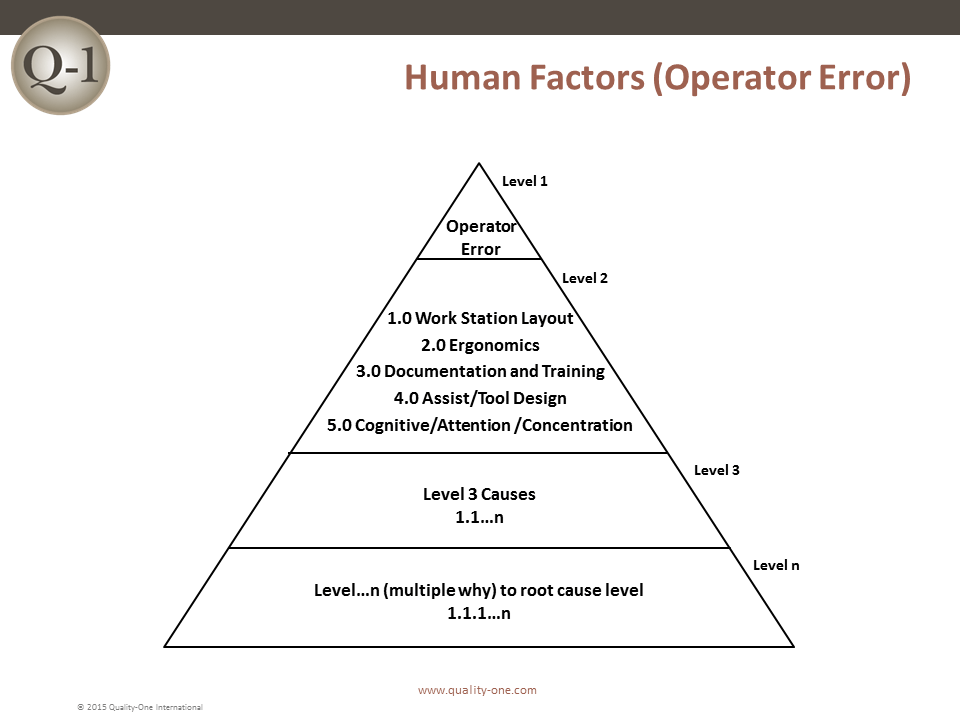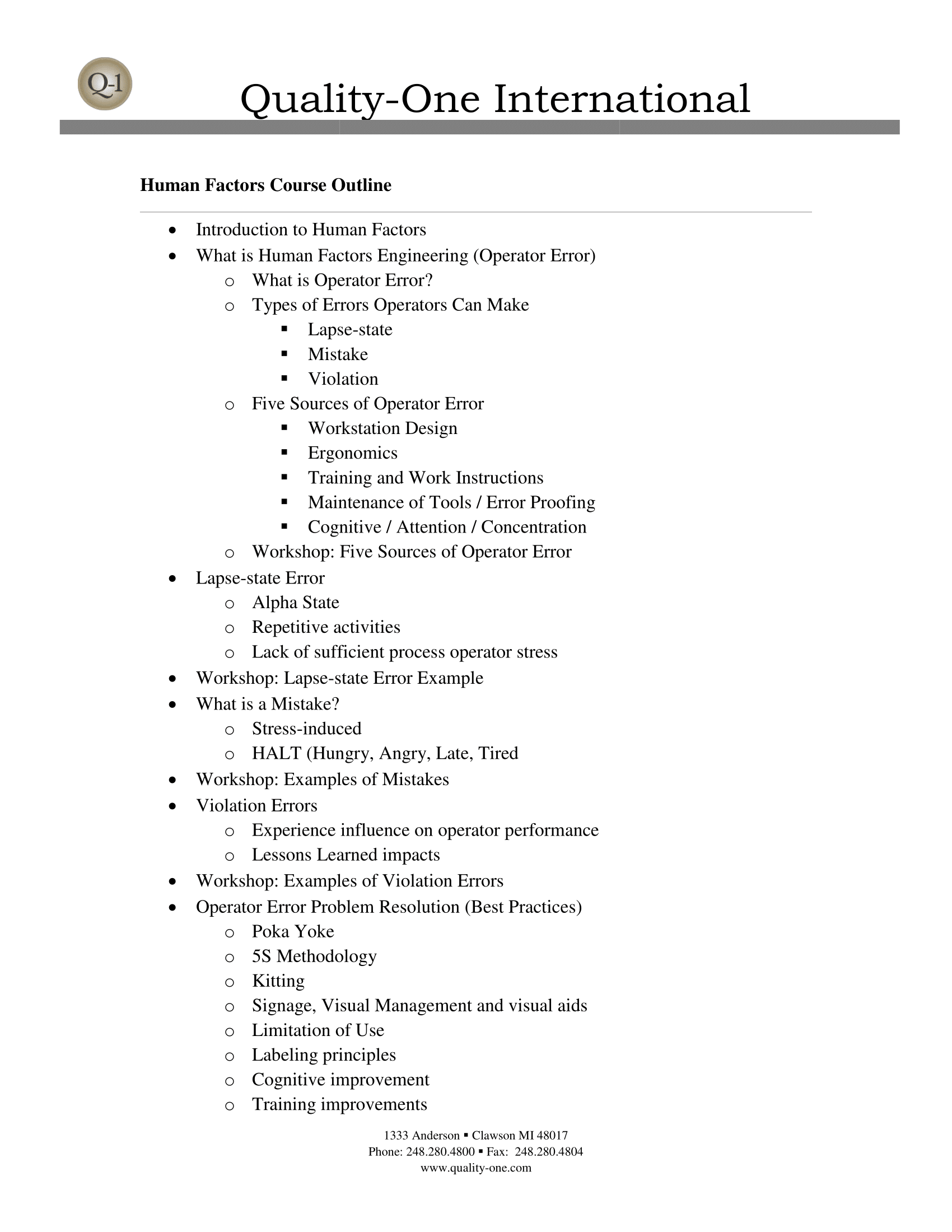HFE
– Human Factors Engineering –

Introduction to Human Factors Engineering
To say that accidents and quality problems happen due to operator error is like saying falling is due to gravity (Kravitz). The fall has a starting point (loss of footing), allowing gravity to do its part. The term “Operator Error” is used universally in Root Cause Analysis (RCA) and Failure Mode and Effects Analysis (FMEA) development. This is an unacceptable cause of failure! Stating the cause as Operator or Human Error does not lead to the root of the problem. To clarify, operator error is a real thing and often present. However, quality problems are not due to an operator error, rather it is the condition the operator has been inserted into which is the source of the error.
Operator Error is not permitted as a response to a root cause because it does not provide a direction to discover the condition affecting the operator which existed at the time of the error. It also does not clearly define the path of action to prevent a similar future event.
The inevitability of Human Error dictates that designs must include an analysis of how humans can influence failure. This approach is expanded into product design, machine design interfaces and process design and methodology.
Human Error does not always result in failure. But errors occur all the time. For example, if an operator of an automobile did not see a stop sign, there are three possible effects:
- Accident / Injury
- Ticket or Violation
- No Effect, as the vehicle glides through unscathed
When analyzing Human Factors, one should consider the worst-case scenario to determine the level of study and commitment to Error Proofing, Reduction of Variation or Mistake Proofing.
What is Human Factors Engineering
Human Factors Engineering (HFE) originated in World War II when it became apparent that individually training the multitude of military personnel was impractical. The published resulting processes and techniques were standardized for ergonomics and consistency. Human Factors Engineering was further developed as military equipment became more technologically advanced. The designs needed to be more user-friendly verses training-dependent and the expectation of personnel becoming more capable over time.
Human Factors is the study of all factors related to the human interface with the machinery, process and environment to make work easier to do the correct way. Human Factors is often associated with ergonomics but is much broader than ergonomics alone and includes the physiology and psychology of the operator expected to perform a task. When applied to a problem, HFE is the study of factors which contributed to the operator not completing the task correctly. Operator Error is studied in RCA, when the human is indicated as the center of the problem being studied. When applied in machine or process design, HFE prevents failures by eliminating or making aware of process conditions which could result in human error. Quality-One recommends the inclusion of Human Factor Engineering in Advanced Product Quality Planning (APQP).
Why Implement Human Factors Engineering
The human is one link of a failure chain but not always the decisive factor. In aviation, the ratio of errors to accidents is 600 to 1, with each error potentially resulting in a catastrophic event. In an industrial environment, anecdotal evidence has surfaced which infers personnel make 7 errors a day. As stated previously, not every error will result in failure. The revelation that many errors are made daily, and could result in failure, provides the drive to improve or error proof the process.
When applying Human Factors to process design, risk is used to determine both the consequence of failure and the probability of each human error identified. Risk reduction techniques, like FMEA and Fault Tree Analysis (FTA), must include the impact of people on the successful deployment of a product or process. We are all affected every day by thoughtful Human Factors Engineering. Most people are aware of HFE through the newest automotive safety features such as:
- Standardized icons for identification
- Cockpit ergonomic design
- Automatic braking
- Lane departure warnings
- Passive road rumble strips
- Active rest warnings and alarms
This design philosophy extends beyond just automobiles into many products that we use daily. Each human error identified and eliminated has the benefits of:
- Fewer defects being produced
- Fewer injuries on the job
- Increased interest in the job
- Reduced equipment downtime
Types of Errors
There are three main categories of errors that people can make:
- Lapse state
- Mistake
- Violation
The lapse state error is made when the operator is thinking about something else. The daydreaming effect results in lower awareness of the work being performed. The lapse state results in an operator adding an incorrect or omitting a key part, movement, or motion without awareness of the condition. The root of the lapse state error is the physiology of the human brain. When bored or without proper stimulation, the operator begins to think of more interesting topics while still performing a task. For example, have you ever driven home late at night and upon arrival realize you did not remember driving?
The mistake happens when the operator is asked to do a complex task which they are not prepared to do. In this state there is excessive stress present which leads to frustration and errors. The errors in this case are very much realized by the operator.
The violation is an act of improvement originated by the operator. The human is convinced they know a better way and begin to change the process based on their experience. This is not always bad, as improvements can be realized by watching or engaging operators in the process. The problem arises when the change either eliminates a safe guard or bypasses a step. The value of the omitted content or step is lost when the product or process is used, resulting in failure.
When identifying the type of error that people can make, the potential improvement or solution can be selected from five categories:
- Work Station Design
- Ergonomics
- Training and Documentation
- Tooling Design
- Cognition and Concentration
Inadequate Work Station design can allow errors by not clearly identifying and separating items which can easily be omitted or chosen improperly. Similar parts, tools and identification markings can easily be confused by operators resulting in wrong assembly. Lapse state and mistakes are typical errors which are probable due to work station design.
Ergonomics can result in error by making it difficult to perform the operation. Operators will violate the process to protect their own physical health. Work station height, reaching, lifting and excessive waist motion are all possible reasons for violation.
Training and Documentation can be improperly selected for an operation. The multiple pages of a work instruction may contribute to complacency. If the work instruction is too long and too complex with excessive descriptions, it will quickly be discounted by the operator as not helpful. Training is also a misunderstood source of error. Training designed for conveying a positive message without balance toward what can go wrong does little to improve operator performance.
Tooling Design can result in error if error proofing devices are defeated or changed to make them easier to use. If a tool is difficult to operate, it likely will not be used as intended. Tooling modification is a violation which can result in human error.
Cognitive and Concentration, sometimes also referred to as situational awareness, can be impacted by making it too easy or a lack of appropriate stress. Some stress is required to keep an operator engaged or interested in the process. The cognitive focus will degrade after a short period of time if the operator is not actively kept in engagement. It is up to the process design to periodically stress the operator to keep their focus. Lapse state errors are the primary type of error associated with Cognitive and Concentration.
How to Implement Human Factors Engineering
When implementing Human Factors Engineering, the first step is to build a cross functional team to review the process. The team should consist of an ergonomist, operators, manufacturing engineers, quality engineers and production supervisors, among others. Each member of the team should have received proper training in Human Factors and possess a thorough knowledge of the process to be reviewed, including any history of process errors or product defects.
Step 1: Identify and Prioritize the Opportunity
Determine the consequence of failure on the machinery, user, customer, etc., due to operator error or determine the hazards to operators if failure occurs.
Step 2: Select the Process
Select the specific process to evaluate. If the design of the process is still open for change, implementation of Human Factors is more financially beneficial to the organization rather than waiting until failure occurs to study the impact. The point is to select the process with the most potential for improvement as early as possible.
Map the Process
Use a Value Stream Map (VSM) or Process Flow Diagram to review the macro level stages of work. Where opportunity has been previously determined, review each step in the process at the micro level. If a VSM or Process Flow does not exist, create one.
Identify Risk of Operator Error
Have the team brainstorm to identify all of the possible errors that could occur within the process. Think about where and when human errors are likely to occur. The Process FMEA is an effective tool for identifying risk in a process and prioritizing each of the potential errors.
Locate the Source
For each potential error, work back through the process to determine the source or point of creation. The type of error and the category of improvement can be identified at this step. Look for ways to prevent the error from occurring through examination of the point of origin.
Step 3: Review Options
After identifying the potential errors, have the team select from past proven techniques and/or brainstorm potential methods of making it impossible for the error to occur. See the following options for addressing potential errors:
- Work Station Design
- Modify the step by making the correct action simpler to perform than the error
- Eliminate the step by asking if this step required and does it add value
- Error Proof the step by making it impossible for the error to occur
- Utilize color or icons (rather than numbers) for part identification
- Ergonomics
- Reduce the number of motions
- Utilize adjustable table heights and standardized reach
- Reduce mass or weight of the parts in the operation or provide an assist
- Training and Documentation
- Develop work instructions in visual format instead of words
- Identify priority of importance utilized for the visual aids
- Pictures / sketches / video used to greatest advantage
- Train using multi-faceted repetitive approach
- Include periodic demonstration of capability
- Tooling Design
- Utilize error proofing devices that have diagnostics
- Include the importance of devices and consequences of failure in training
- Apply standard practices for tool design and error proofing
- Cognitive and Concentration
- Periodic station rotation
- Add alarms to the process
- Feedback to operators is random and not all the time
- Application of active engagement in process design
Select the Method for Mistake Proofing
If the human factor / operator error cannot be simplified or eliminated, then select the appropriate device, method of warning or mistake proofing for the operation. Some examples may be:
- Audible alarms, flashing lights, line lockouts (warnings)
- The contact method identifies product defects through assessment of the product’s shape, size, color or other physical characteristics
- The fixed-value (or constant number) method alerts the operator if a certain number of movements are not made
- The motion-step (or sequence) method determines whether the prescribed steps of the process were completed
Step 4: Implementation
Develop and implement the Human Factors strategy into the process design. Always communicate with operators about the changes made and how it will benefit them. Also emphasize the consequences of failure as this adds beneficial stress into the worker’s system.
Step 5: Verification and Validation
Measure the effectiveness of the Human Factors strategy, Poke Yoke or Mistake Proofing device / method. Monitor for improvements in efficiency, reduction in errors, rework and scrap. Determine whether the change was effective.
Step 6: Standardize and Catalog for Continuous Improvement
Standardize the actions for use throughout the organization. Continue to review the processes and look for ways to prevent operator errors that could result in defects until it becomes part of the organizational culture. Never ending continuous improvement should become part of the daily routine as well. Human Factors Engineering can be implemented into any step within a manufacturing process where human error occurs. HFE implementation will yield multiple benefits to process efficiency, product quality and reduced scrap.
Human Factors Engineering Services
The Human Factors Engineering Services available from Quality-One are Consulting, Training and Support, which may include Facilitation, Auditing or Contract Services. Our experienced team of professionals will provide a customized approach for developing your people and processes based on your unique Human Factors needs. Whether you need Consulting to assist with a plan to deploy a new Human Factors initiative, training to help understand and drive improvement or hands-on Project Support for building and implementing your selected Human Factors strategy, Quality-One can support you! By utilizing our experienced Subject Matter Experts (SME) to work with your teams, Quality-One can help you appreciate the value of Human Factors Engineering in your organization.
Learn More About Human Factors Engineering
Quality-One offers Quality and Reliability Support for Product and Process Development through Consulting, Training and Project Support. Quality-One provides Knowledge, Guidance and Direction in Quality and Reliability activities, tailored to your unique wants, needs and desires. Let us help you Discover the Value of Human Factors Engineering Consulting, Human Factors Engineering Training or Human Factors Engineering Project Support.


